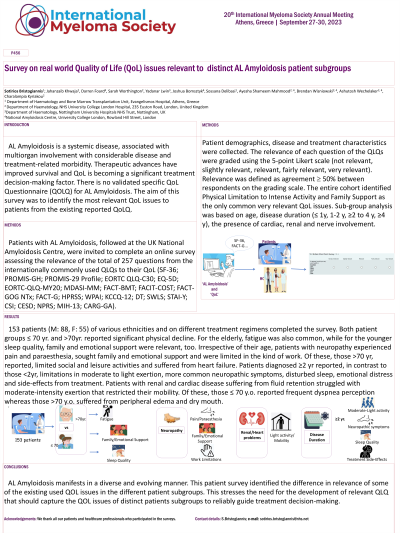QoL and Patient-Reported Outcome and Supportive Care
Poster Session 3
P-456: Survey on real world Quality of Life (QoL) issues relevant to distinct AL Amyloidosis patient subgroups
Friday, September 29, 2023
1:15 PM - 2:15 PM EEST


Sotirios Bristogiannis
Haematology Registrar
Evangelismos General Hospital, Athens, Greece
Athens, Attiki, Greece
Introduction: Amyloidosis is a systemic disease, associated with multiorgan involvement with considerable disease and treatment-related morbidity. Therapeutic advances have improved survival and QoL is becoming a significant treatment decision-making factor. There is no validated specific QoL Questionnaire (QOLQ) for AL Amyloidosis. The aim of this survey was to identify the most relevant QoL issues to patients from the existing reported QoLQ.
Methods: Patients with AL Amyloidosis, followed at the UK National Amyloidosis Centre, were invited to complete an online survey assessing the relevance of the total of 257 questions from the internationally commonly used QLQs to their QoL (SF-36; PROMIS-GH; PROMIS-29 Profile; EORTC QLQ-C30; EQ-5D; EORTC-QLQ-MY20; MDASI-MM; FACT-BMT; FACIT-COST; FACT-GOG NTx; FACT-G; HPRSS; WPAI; KCCQ-12; DT; SWLS; STAI-Y; CSI; CESD; NPRS; MIH-13; CARG-GA). Patient demographics, disease and treatment characteristics were collected. The relevance of each question of the QLQs were graded using the 5-point Likert scale (not relevant, slightly relevant, relevant, fairly relevant, very relevant). Relevance was defined as agreement ≥ 50% between respondents on the grading scale. The entire cohort identified Physical Limitation to Intense Activity and Family Support as the only common very relevant QoL issues. Sub-group analysis was based on age, disease duration (≤ 1y, 1-2 y, ≥2 to 4 y, ≥4 y), the presence of cardiac, renal and nerve involvement.
Results: 153 patients (M: 88, F: 55) of various ethnicities and on different treatment regimens completed the survey. Both patient groups ≤ 70 yr. and reported significant physical decline,For the elderly, fatigue was also common, while for the younger sleep quality, family and emotional support were relevant, too Irrespective of their age, patients with neuropathy experienced pain and paresthesia, sought family and emotional support and were limited in the kind of work. Of these, those >70 yr, reported, limited social and leisure activities and suffered from heart failure. Patients diagnosed ≥2 yr reported, in contrast to those < 2yr, limitations in moderate to light exertion, more common neuropathic symptoms, disturbed sleep, emotional distress and side-effects from treatment. Patients with renal and cardiac disease suffering from fluid retention struggled with moderate-intensity exertion that restricted their mobility. Of these, those ≤ 70 y.o. reported frequent dyspnea perception whereas those >70 y.o. suffered from peripheral edema and dry mouth.
Conclusions: AL Amyloidosis manifests in a diverse and evolving manner. This patient survey identified the difference in relevance of some of the existing used QOL issues in the different patient subgroups. This stresses the need for the development of relevant QLQ that should capture the QOL issues of distinct patients subgroups to reliably guide treatment decision-making.
Methods: Patients with AL Amyloidosis, followed at the UK National Amyloidosis Centre, were invited to complete an online survey assessing the relevance of the total of 257 questions from the internationally commonly used QLQs to their QoL (SF-36; PROMIS-GH; PROMIS-29 Profile; EORTC QLQ-C30; EQ-5D; EORTC-QLQ-MY20; MDASI-MM; FACT-BMT; FACIT-COST; FACT-GOG NTx; FACT-G; HPRSS; WPAI; KCCQ-12; DT; SWLS; STAI-Y; CSI; CESD; NPRS; MIH-13; CARG-GA). Patient demographics, disease and treatment characteristics were collected. The relevance of each question of the QLQs were graded using the 5-point Likert scale (not relevant, slightly relevant, relevant, fairly relevant, very relevant). Relevance was defined as agreement ≥ 50% between respondents on the grading scale. The entire cohort identified Physical Limitation to Intense Activity and Family Support as the only common very relevant QoL issues. Sub-group analysis was based on age, disease duration (≤ 1y, 1-2 y, ≥2 to 4 y, ≥4 y), the presence of cardiac, renal and nerve involvement.
Results: 153 patients (M: 88, F: 55) of various ethnicities and on different treatment regimens completed the survey. Both patient groups ≤ 70 yr. and reported significant physical decline,For the elderly, fatigue was also common, while for the younger sleep quality, family and emotional support were relevant, too Irrespective of their age, patients with neuropathy experienced pain and paresthesia, sought family and emotional support and were limited in the kind of work. Of these, those >70 yr, reported, limited social and leisure activities and suffered from heart failure. Patients diagnosed ≥2 yr reported, in contrast to those < 2yr, limitations in moderate to light exertion, more common neuropathic symptoms, disturbed sleep, emotional distress and side-effects from treatment. Patients with renal and cardiac disease suffering from fluid retention struggled with moderate-intensity exertion that restricted their mobility. Of these, those ≤ 70 y.o. reported frequent dyspnea perception whereas those >70 y.o. suffered from peripheral edema and dry mouth.
Conclusions: AL Amyloidosis manifests in a diverse and evolving manner. This patient survey identified the difference in relevance of some of the existing used QOL issues in the different patient subgroups. This stresses the need for the development of relevant QLQ that should capture the QOL issues of distinct patients subgroups to reliably guide treatment decision-making.
